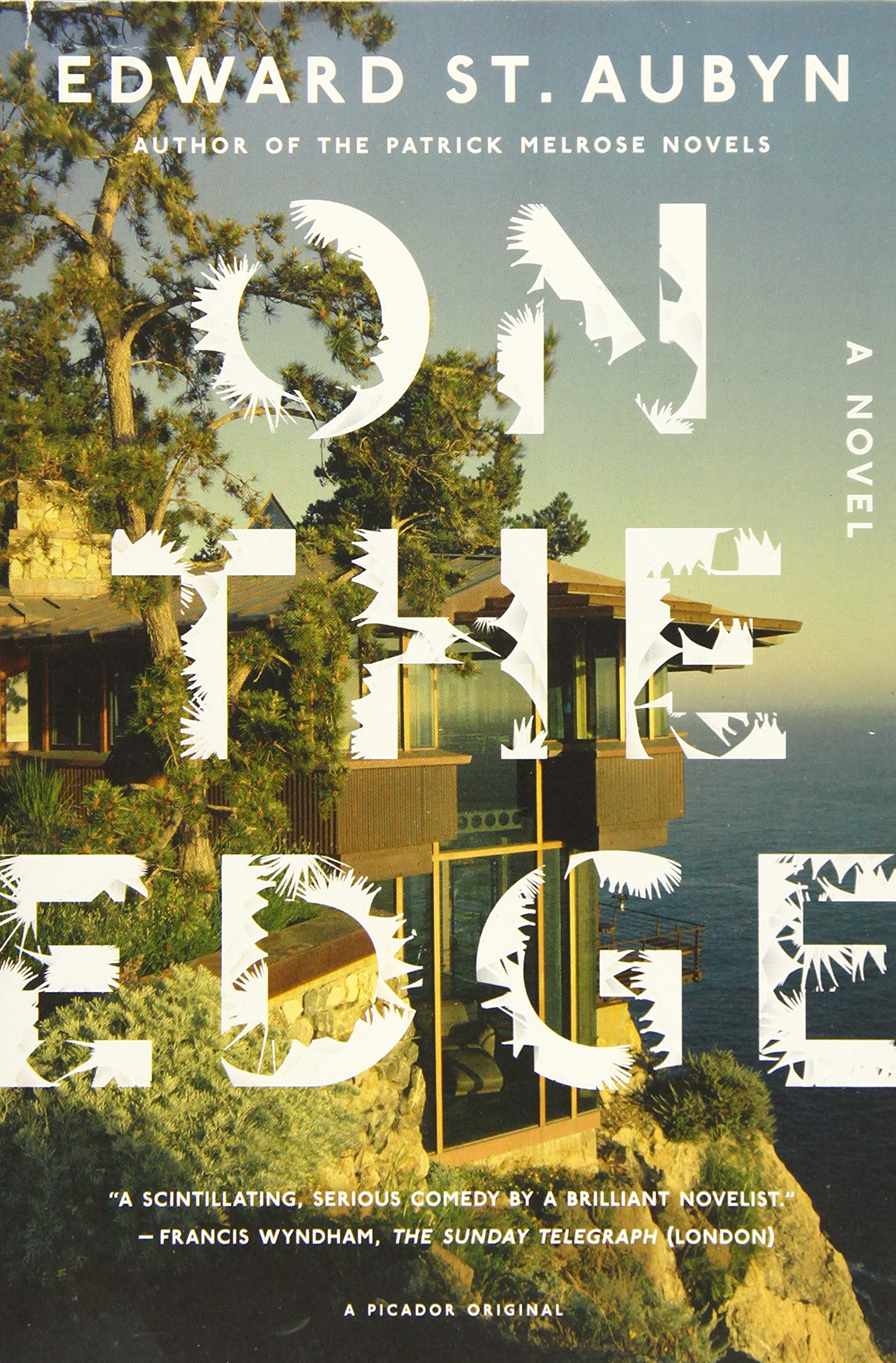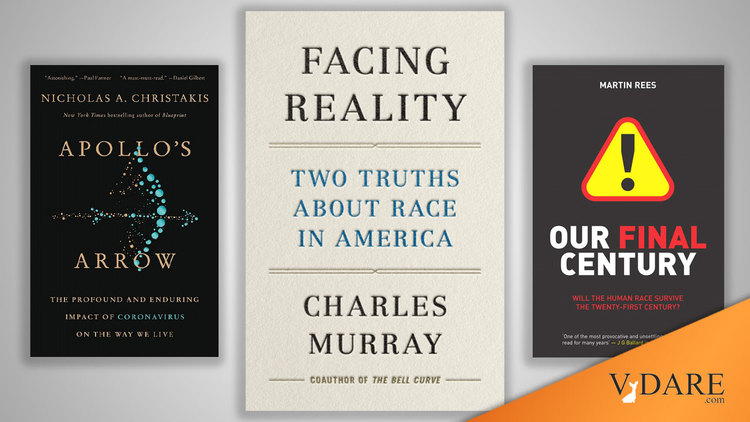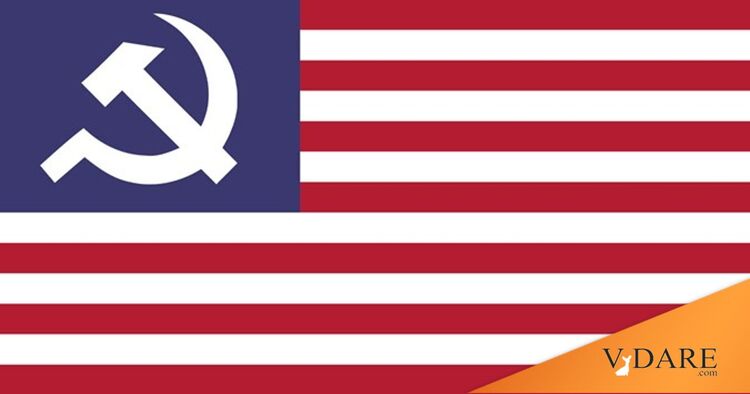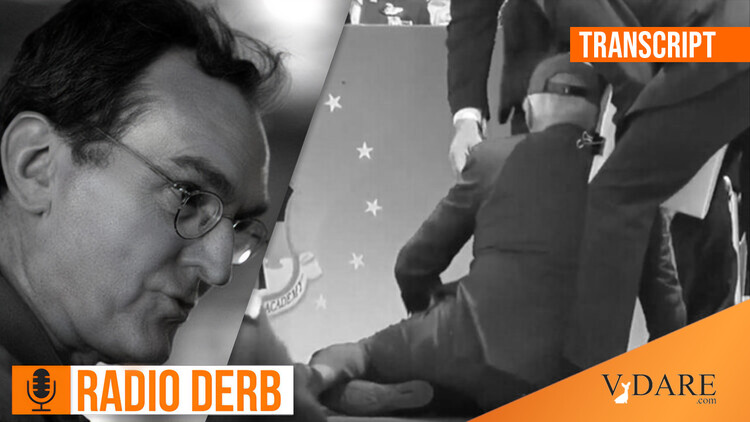Charles Murray's FACING REALITY. If you belong to the fast-dwindling demographic that believes in objective truth, you will like Charles Murray's new book, pub date June 15: Facing Reality: Two Truths about Race in America.
 Murray writes two distinctly different kinds of book, long and short. In the long books (most recently Human Diversity) Murray gives full rein to his passion for data, and for the deep truths hidden in big datasets. The shorter books, like his 2008 Real Education, are more journalistic and less challenging for a reader not well acquainted with statistics.
Murray writes two distinctly different kinds of book, long and short. In the long books (most recently Human Diversity) Murray gives full rein to his passion for data, and for the deep truths hidden in big datasets. The shorter books, like his 2008 Real Education, are more journalistic and less challenging for a reader not well acquainted with statistics.
(And I just noticed, looking up Real Education for the link, that its full title includes the word "reality," just as this new book's title does. Charles Murray, like your genial diarist, clings to a fusty, absurdly old-fashioned belief in objective reality quite independent of our feelings, wo wo wo feelings.)
This latest Murray book is one of the shorts: 125 pages of main text, with three pages of introduction, twenty pages of endnotes, four pages of maps, and a five-page index. There are several tables and a small handful of graphs (this one my favorite):

but not much heavy-duty quantitative analysis—little enough that a math-challenged reader can skip over it without serious loss.
Neither of the two truths in Murray's title will surprise VDARE.com readers. In the author's own words, from the book's introduction:
The first is that American Whites, Blacks, Latinos, and Asians, as groups, have different means and distributions of cognitive ability. The second is that American Whites, Blacks, Latinos, and Asians, as groups, have different rates of violent crime.
Our public culture seems incapable of dealing with these facts other than by denial and dishonesty: "The assailant was described as a heavy-set male of about thirty, wearing a red jacket …" Hence the social stresses and strains we are all wearily familiar with.
What is to be done? Murray's prescription is civic nationalism. We can all get along, he says, if we will just stay true to the principles on which our nation was founded and face reality.
You can applaud that—and I do—as coming from a generous, good-hearted patriot and seeker after truth. You can also mock it—and many on our side of the fence surely will—as a naive civ-nat "bravery signaller" murmuring emollient words into a howling gale of unreason.
What, after all, will be the united response to Murray's two truths, assuming they deign to notice them, from all the commanding heights of our culture—from the media, the academy, the churches, all three branches of government? SYSTEMIC RACISM! LEGACY OF SLAVERY! SOCIAL CONSTRUCT! WHITE SUPREMACY! PRIVILEGE! BIGOT! BURN THE WITCH!
The great mass of people don't share Murray's enthusiasm for data, for facts, for careful empirical inquiry. They have no patience with z-scores and correlation coefficients. They are not interested in objective reality unless it grows their food or powers their gadgets. They want magic and religion. They want drama: saints and martyrs, heroes and villains, Good versus Evil.
In the Western world today those universal inclinations are directed by the widespread desire among white people, especially white women, to kneel and abase themselves before other races, to denounce their own ancestors and belittle all their achievements.
In the human realm, that is reality.
A dramatic rise in risk aversion. As mentioned in my May 14th podcast, I get emails grumbling that I don't say half as much as I should about the Covid pandemic.
I put it down to my native fatalism, which (I said) I think is common in people of my generation, perhaps especially English people.
Flu pandemics are, to those of our inclination, just part of the unavoidable background of life, like the weather. You don't take foolhardy chances with them, any more than you go out without an umbrella when it's raining, but you get on with your life and don't make a fuss about them.
 Whatever the reason, I can't be much bothered with the pandemic. When I do my morning scan of the news sources after breakfast, I skip over the Covid news. It's not interesting to me.
Whatever the reason, I can't be much bothered with the pandemic. When I do my morning scan of the news sources after breakfast, I skip over the Covid news. It's not interesting to me.
In a spirit of commentatorial duty I bought a copy of Nicholas Christakis' book about Covid shortly after it came out a few months ago. I dutifully read a little more than half of it, according to the bookmark, and … it's been sitting on my shelf untouched ever since. Not everybody is interested in everything. Even we big-brained polymaths have our can't-be-bothered zones.
I'm the same with abortion, concerning which there is something or other going on newswise this month. I couldn't care less. Free abortion booths at Walmart; capital punishment for abortionists; I'm fine either way. In my National Review days I had a regular email correspondent who insisted that abortion was the paramount issue and should be a deal-breaker for every voter. Good luck to him: it's just not on my list.
Likewise UFOs. I generally catch Tucker Carlson's show on Fox News, and cheer him when he takes a stand against the anarchist mobs and nation-wreckers. (Although I wish he'd stop saying "skin color" as a euphemism for "race." Yo, Tucker, check this out.) When he starts on the UFO stuff, though, I take a break and play with the dog. My interest in UFOs peaked around 1955 and has been declining asymptotically ever since.
 And, circling back, there's that generational thing, too. I have not yet read this new book by Brit historian Niall Ferguson (not to be confused with epidemiologist Neil Ferguson). The title is Doom: The Politics of Catastrophe, but it's mainly concerned with epidemics, especially Covid.
And, circling back, there's that generational thing, too. I have not yet read this new book by Brit historian Niall Ferguson (not to be confused with epidemiologist Neil Ferguson). The title is Doom: The Politics of Catastrophe, but it's mainly concerned with epidemics, especially Covid.
(I should like to have been a fly on the wall in Ferguson's meetings with his publisher's editors. His last book had come out in 2018, so I'd guess the proposal for this one was being considered in 2019. Did it have lots of stuff about famines, floods, earthquakes, Chernobyl, and such, with just a chapter or two about epidemics? And then, when Covid was all over the news early last year, did the editors press him to expand the epidemic material and reduce the rest? Don't know, just speculating.)
As I said, I haven't read the book yet. I did, though, read the review of it by a different British historian, Jonathan Sumption, in the May issue of Literary Review. From which, concerning America's response to the Asian (1957–58) and Hong Kong (1968–70) flu epidemics:
The federal government's interventions were limited to supporting vaccine research. The death rate was high, but the economic damage was minimal. No one complained at the time, and Ferguson himself appears to approve of the US government's approach. He observes, rightly, that the main difference between these outbreaks and the current pandemic is a dramatic rise in risk aversion among Western populations in the intervening decades. [Prime Minister versus Pathogen]
Betting on Covid. Eighteen years ago I reviewed a book titled Our Final Hour by Sir Martin Rees, Britain's Astronomer Royal. From my review:
In Britain the book sells under the title Our Final Century, which expresses its theme a bit more precisely. Sir Martin doesn't think that we—the human race—are going to make it alive through to 12/31/2099, and he has given a bookful of reasons for his opinion.
 Sir Martin is still among us, now 78 years old, and he is still Britain's Astronomer Royal. (Which is not an empty honorific: he has had a distinguished career as a working astrophysicist.)
Sir Martin is still among us, now 78 years old, and he is still Britain's Astronomer Royal. (Which is not an empty honorific: he has had a distinguished career as a working astrophysicist.)
In my review I quoted this passage from Sir Martin's book:
I staked one thousand dollars on a bet: "That by the year 2020 an instance of bioerror or bioterror will have killed a million people." Of course, I fervently hope to lose this bet. But I honestly do not expect to …
Let's leave aside the ambiguity of "by the year 2020." Did he mean that inclusive of the actual year 2020, or exclusive? I'll assume inclusive. Then by December 31st, 2020 Covid surely had killed a million people worldwide.
So now, to settle Sir Martin's bet, we need to know whether Covid is "an instance of bioerror or bioterror." Unfortunately, as I've argued on my podcast, while there is good circumstantial evidence favoring bioerror, and a case can be made for bioterror, we may never know for sure.
Does Sir Martin have an opinion on the matter? Has he made any attempt to claim a win? The post of Astronomer Royal only pays £100 per annum; but after such a long and glittering career, Sir Martin should be pretty well off from other sources. Has he thought of funding a private inquiry into the origins of Covid, just to settle his bet?
Trying St. Aubyn. Last month, after passing some comments on Jojo Moyes 2019 novel The Giver of Stars, I lamented the absence of honest reactionaries from the ranks of today's British novelists.
A reader emailed in with a suggestion: "How about Edward St. Aubyn?"
I had never read any of St. Aubyn's novels, so I thought I'd try one. Not willing to spend my fast-depreciating dollars on an unknown quantity, I headed down to my municipal library, now re-opened. They had three of St. Aubyn's novels on the fiction shelves, none of them belonging to the set of five Patrick Melrose novels, 1992–2012, that made St. Aubyn famous (although obviously not to me). I picked one of the three at random, took it home, and read it.
 This was St. Aubyn's 1998 novel On the Edge, a send-up of New Age flapdoodle, set mostly at the Esalen Institute in Big Sur. All but one of the characters are middle-class malcontents seeking spiritual fulfillment via pasted-together bits of oriental mysticism. The exception is an Englishman chasing a girl he knows to be a New Age-ist.
This was St. Aubyn's 1998 novel On the Edge, a send-up of New Age flapdoodle, set mostly at the Esalen Institute in Big Sur. All but one of the characters are middle-class malcontents seeking spiritual fulfillment via pasted-together bits of oriental mysticism. The exception is an Englishman chasing a girl he knows to be a New Age-ist.
So spoken utterances tend to go like this:
"The thing you notice that you haven't noticed that you don't have is the thing that really matters," said Jerome, beaming vibrational energy at Peter. "Think about it."
St. Aubyn gets some good Waughish fun from the Englishman lost among Americans:
Gosh, thought Peter, these California girls are amazing. He felt his own Englishness and stiffness and inability to decipher Crystal's candour. If an Englishwoman told you about an orgasm the second time you chatted together, you knew that she either wanted sex straight away, or that she'd been educated at a convent. Over here, one had no idea what it meant.
The New York Times reviewer thought that St. Aubyn's mocking of American manners was the reason the book wasn't published over here until 2014. I'm not so sure. I thought there was something a bit musty, a bit dated about the scenery that might have put publishers off.
I mean, New Age? Really? Is that still a thing worth lampooning? Was it, even in 1998? I read Powers of Mind by "Adam Smith" (real name George Goodman) when it came out in 1975, and laughed all the way through. By 1998, however, anything to do with New Agery had sunk down into the sludge at the bottom of my mind, making it pretty spoof-proof.
And then, sex. The last thirty or so pages of the novel concern a weekend workshop in Tantric sex … lots of it, very explicitly described. Again, is that still a thing in novels? I thought that vein had been thoroughly worked out by 1993, the year Literary Review initiated its annual Bad Sex in Fiction Award for "the year's most outstandingly awful scene of sexual description in an otherwise good novel."
Perhaps St. Aubyn had actually won the award in 1998. I checked the list of winners on Wikipedia: no, no St. Aubyn at all.
Probably there is some level of irony here I'm not appreciating. Probably these quaint 1970s-ish themes are the main point of the novel in some way that's over my head. I'm a bit too literal-minded to be deeply literary.
Well, at least I finished On the Edge, which puts it in the top tercile of novels I try. On my next trip to the library I'll ask if they can get me the Patrick Melrose pentalogy. And I'm glad to have learned "soft-on." I didn't know there was a word for that.
The only truth is subjective truth. My lament about there being no honest reactionaries writing novels was committed to pixels in late April and posted online May 3rd. I mention that because Bruce Oliver Newsome issued a related lament at American Greatness, posted May 15th, title: "Where Is Anti-Woke Literature?" Lament:
Where are today's equivalents of the widely published conservative novelists of the 20th century, such as Evelyn Waugh and G. K. Chesterton?
So my complaint was not merely an echo of Dr. Newsome's. I don't think his was an echo of mine, either: he takes a different approach. So no-one's cribbing from anyone here. This is an instance of great minds thinking alike.
"Contemporary fiction is dominated by left-wing themes," Dr. Newsome tells us. It's not just the themes, either: if you want to publish a novel with all the tremendous advantages of doing so through an established publisher (experienced advertising staff, media connections, generous advance, etc.), you had better not be a white male … although if you're woke and homosexual, they might give you a break.
 Even if you are female, Hispanic, and woke, you may not be authentic enough to write a story "about a woman and child fleeing violence in Mexico for America, via the illegal route." That was Jeanine Cummins' 2020 novel American Dirt. Ms. Cummins, who has one Puerto Rican grandparent, was widely criticized for being too white and law-abiding to write about Mexican illegals. Her book tour was canceled.
Even if you are female, Hispanic, and woke, you may not be authentic enough to write a story "about a woman and child fleeing violence in Mexico for America, via the illegal route." That was Jeanine Cummins' 2020 novel American Dirt. Ms. Cummins, who has one Puerto Rican grandparent, was widely criticized for being too white and law-abiding to write about Mexican illegals. Her book tour was canceled.
We are heading rather fast towards a place where the only thing you may write about is yourself. As I noted in my May 14th podcast:
Flaubert wouldn't find a publisher for Madame Bovary nowadays, nor Tolstoy for Anna Karenina, nor, to complete the adultery set, Fontane for Effi Briest
"Write about what you know," is the advice given to young writers … The only thing you're supposed to know nowadays is your own precious self, your—what's the cant expression? oh, right—your "lived experience."
(In some email exchanges with a friend, I wondered what would happen to historical fiction under this dispensation. After all, I observed, Robert Graves was not a Roman Emperor. My friend, who is better-read than I am, trumped that with Marguerite Yourcenar's Memoirs of Hadrian. Not only was Ms. Yourcenar not an Emperor, she was a different sex from her subject—"A complete impostor!")
It's the same in the performing arts, as explained in a terrifying essay by Heather Mac Donald at City Journal, May 23rd. She is writing about the very prestigious Juilliard School of music, drama, and dance in New York City. Juilliard is deep in the throes of an anti-racist hysteria that is upending all their instruction. Writes Mac Donald:
It is taboo to question claims of racism-inflicted disability, since such a challenge denies someone his subjective "truth." When it comes to race, subjective truth is now the only allowable truth.
From what Dr. Newsome told us about fiction publishing, it is not only race that's at issue. For a suitable inscription on the tombstone of Western civilization, you just need the last eight words there:
SUBJECTIVE TRUTH IS NOW THE ONLY ALLOWABLE TRUTH.
Curse of the Woke bimbos. This one properly belongs in the Math Corner. I have a head of steam up on these Cultural Revolution issues, though, so it belongs here equally well. I already have two items scheduled for the Math Corner; if I put this one in with them it'll be more like a Math City Block.
The topic is the collapse of discipline and good sense at the Mathematical Association of America (MAA). I've tackled this issue before, in both my podcast and diaries.
This month's outrage, like the second of those links, concerns Focus, the MAA monthly newsletter. Here is the Table of Contents page for the April/May issue.

As you can see, "in this ISSUE" there are three long-form articles, at pages 18, 22, and 30. Their actual lengths are 2½, 6½, and 3 pages respectively. So that second main article is longer than the other two together. It dominates the issue—it's one-sixth of the issue's 40 pages.
What's it about? "How (and How Not) to be Anti-racist in Mathematics." As you can divine from that title, it is warmed-over Kendi-ism: "embrace the discomfort," "white supremacy culture," "take off your mathematical hat and adorn [sic] a socially conscious one," et cetera, et cetera, et drivelling illiterate cetera.
And that's not even all of the Kendi-ism in the issue. Here's the last half page of the first article, the 2½-page one.
Sample:

 Why is the periodical of a prestigious mathematical society dominated by this poisonous dreck? I think there's a clue on the first page, the one facing the Table of Contents page. Check out the picture of the editor there, Jacqueline Jensen-Vallin, and her accompanying mini-editorial. Nice White Lady, or what? In just 300 words she manages to include "reimagine," "equity," and "#StopAsianHate."
Why is the periodical of a prestigious mathematical society dominated by this poisonous dreck? I think there's a clue on the first page, the one facing the Table of Contents page. Check out the picture of the editor there, Jacqueline Jensen-Vallin, and her accompanying mini-editorial. Nice White Lady, or what? In just 300 words she manages to include "reimagine," "equity," and "#StopAsianHate."
The strong suspicion has to be that MAA Focus has fallen into the hands of woke bimbos. To be sure, the Editorial Board has a Matt, a David, a Michael, a James, a Nicholas, and a Matthew keeping company with Jessica, Dandrielle, Audrey, Jennifer, and Hortensia. (Jamylle and Hwayeon could be either sex—or, as they would probably prefer me to say, "any gender.") The story I hear from friends in the media, however, is that once woke bimbos have any kind of authority, the rest of the newsroom trembles before them. As Orwell taught us a lifetime ago:
It was always the women, and above all the young ones, who were the most bigoted adherents of the Party, the swallowers of slogans, the amateur spies and nosers-out of orthodoxy …
As a supplementary to which, you can add Steve Sailer's observation over at Taki's Magazine, May 26th:
Moreover, every year, less influence in our society is in the hands of semi-well-informed family men like [Matthew] Yglesias and [Ezra] Klein. The younger generation has been marinated in doctrines of black moral, aesthetic, and sexual supremacy, and young women are persuasive at getting whatever the latest fad tells them to want.
I'm going to try to fend off despair, though. The MAA got a new president in February, for a two-year term. This is Jennifer Quinn, a female (of course!) but a grown-up female—not, by appearance at any rate, a bimbo. She likely has clear adult memories of life before the Great Awokening of the early 2010s, before our public discourse tipped over into insanity. Her introductory remarks on taking up the MAA presidency include a few of the cant words—"community," "inclusion"—but in a somewhat perfunctory way that gives me a glimmer of hope.
I hereby, with all proper respect, issue the following plea to Professor Quinn.
Please, I beg you, conduct a thorough purge of the editorial staff at MAA Focus. Restore the magazine to what it was intended to be: a survey of current mathematical events and topics for undergraduate and high school math students, not an anti-white propaganda sheet dominated by 6½-page effusions of ideological gibberish.
Math belongs in the realm of reason; Critical Race Theory does not. It is a politico-religious cult, like the Albigensians, the Taiping, or Communism—nothing to do with mathematics.
Thank you.
A funny feminist! My most entertaining read of the month was Jill Tweedie's memoir Eating Children. I say that with a measure of guilt, as the book is a chronicle of misery and failure.
Tweedie (1936–1993) was a British opinion journalist. I have dim recollections of seeing her byline in The Guardian, Britain's furthest-left daily broadsheet newspaper, around 1980. I don't think I ever actually read any of her stuff. I didn't take The Guardian (although my sister did, and still does), and only engaged with it when bored in other people's houses, dentist's waiting-rooms, and such. I thought of Jill Tweedie, to the degree I thought about her at all, as just another sour feminist Guardianista.
Then last month, as reported in my Diary, I read Alan Brien's sort-of novel about Lenin. Doing some peripheral browsing, I noticed that Brien was married to Tweedie from 1973 until she died from motor neurone disease twenty years later. (Eating Children includes a touching memorial tribute from Brien.)
Being a fan of Brien's, I thought there must have been more to Tweedie than I'd supposed, so I bought her book. It is, as I said, a chronicle of misery and failure. The miseries are those of a mid-20th-century upper-middle-class English gal: not famine, plague, enslavement, or gang rape by invading barbarians, only unhappy childhood (Tweedie hated but feared her father, loved but pitied her mother), a disastrous marriage, loss of a child, underemployment, loneliness, a failed suicide attempt.
So why did I enjoy the book so much? Was it Schadenfreude, a callous gloating over the misfortunes of someone I dislike? If it was that, I'd be ashamed to write about it.
I'm not at all sure that I would have liked Jill Tweedie in person, but she was a very good writer, and stirred my sympathies in proper degree at the appropriate places. It was her frank self-knowledge that kept my attention, and the unillusioned honesty with which she describes the various social and personal messes she got into.
And she is funny. Here she was in the early 1950s, aged about sixteen, at a finishing school in the Swiss alps with a gaggle of other late-adolescent girls. They were all infatuated with M. Bernard, the young, handsome, tanned ski instructor. He did not reciprocate their interest, leading them to conclude that he was homosexual, although he probably just thought that a liaison would cause more trouble than his job was worth.
Skiing itself, the fear, the loneliness, the whistling speed, the blissful swish of blade on snow, was very heaven. Down we whizzed one after the other, slaloming grandly from side to side while in and out between us wove M. Bernard in a shower of snow, the bobble on his cap wobbling madly, his voice floating thinly back to us.
"Gardez les genoux ensemble, jeunes dames! Toujours les genoux ensemble!"
That classic instruction to young ladies, keep your knees together, caused instant and dangerous wobblings in the ranks and Margaret Tulley, quite unbalanced by laughter, promptly closed with a tree, which doomed her to a Christmas in plaster, a casualty of love.
Catching up with Classic Lit. I have never read Moby Dick, nor The Last of the Mohicans, nor The Red Badge of Courage. I mean, I have not read the actual books. I know the plot lines pretty well, though, from having read the Classics Illustrated versions in my teens.
 I just learned this month that Classics Illustrated are now online at the Internet Archive. Moby Dick? Check. The Last of the Mohicans? Check. The Red Badge of Courage? Check.
I just learned this month that Classics Illustrated are now online at the Internet Archive. Moby Dick? Check. The Last of the Mohicans? Check. The Red Badge of Courage? Check.
Where the classics are concerned, I think I was a typical mid-20th-century bookish English-speaker. By the time I reached adulthood I had read a creditable number of classics in the flesh, as it were—plain text, with at most an occasional illustration. I'd read some for pleasure, having been gifted them by adults as suitable reading for youngsters; others from having had my interest piqued by a movie; others as school tasks.
Outside that core of read books was a penumbra of famous works, like the aforementioned, that I knew only from Classics Illustrated.
(Now I come to think of it, in fact, American authors were over-represented in that penumbra. Nations, even cousin nations, favor their own writers, I guess. The books adults gave us, and the ones forced down our throats at school, were nearly all British. I think the only American titles ranked high up in every list of approved books-for-kids in 1950s Britain were Tom Sawyer and Little Women.)
Beyond the penumbra lay the great dark territory of Never-Read-It. In subsequent decades I've pushed the darkness outwards considerably, but of course have not eliminated it. Nobody's read everything, although I think Tony Daniels, alias "Theodore Dalrymple," has come close.
Contemplating that darkness now, and knowing that Classics Illustrated are available online for free, I may do some quick'n'dirty catching-up on literary classics I've missed.
Math Corner. Reading back over this diary, it's way too bookish. I really should get out more. Having taken the theme this far, though, it'll hardly notice if I close with one more book-related item.
Both my kids attended college and I was always stunned at how much they paid for second-hand textbooks—as much as I pay for new non-textbook books.
I was stunned again this month. An engineer named Naji Arwashan has written a book about the Riemann Hypothesis. He read my 2003 book on that topic, and had kind things to say about it. We have exchanged several cordial emails.
Dr. Arwashan's book, The Riemann Hypothesis and the Distribution of Prime Numbers, is out now from Nova Science Publishers. You can see the table of contents at that link and purchase a copy if you want to. From some short extracts I have seen, it is very well done, and ventures wider and deeper in the math than my book did.
The book sells for $160!
No, that's not factorial 160 dollars (which would be $471 million trillion trillion trillion trillion trillion trillion trillion trillion trillion trillion trillion trillion trillion trillion trillion trillion trillion trillion trillion trillion trillion trillion trillion and change), although where my book-buying budget is concerned, it might as well be.
What's going on with the price of a book here? I consulted a friend, a retired academic, at a dinner we were both attending. He gave me a detailed explanation. We were three or four glasses of wine into the dinner, though, and my faculties were not at their sharpest. When I tried to retail his explanation to Mrs. Derbyshire a day or two later, it went like this:
Me: "See, for academic books that college lecturers can insist their classes buy every year, the secondary market has totally taken over. Every student in class buys a used copy at the beginning of the semester. Then, at the end of the semester, he sells it back to the used-book dealer. Publishers get nothing from all that. To cover their costs, they have to charge high prices for a new book."
She: "But then, who gets the wheel turning? Who buys the book new at the high price?"
Me: "Uh …"
Mysterious thing, commerce.
Brainteaser. I have parked two semicircles inside a circle, as shown. What looks to be the case, is the case: AB and CD are parallel, E is a single point of contact.

Prove that, within the larger circle, the shaded area is equal to the non-shaded area; in other words, that the sum of the areas of the two semicircles is half the area of the big circle.











